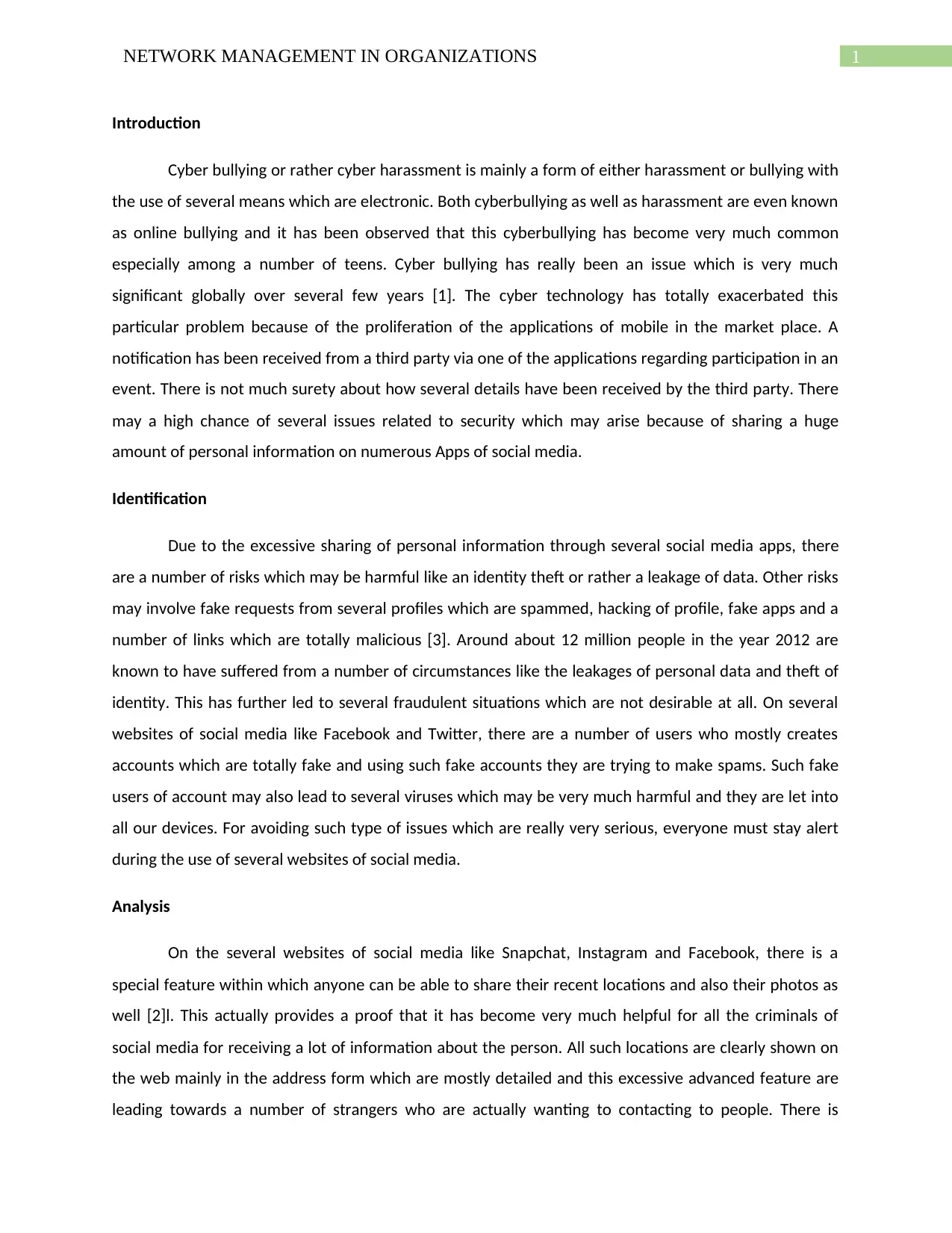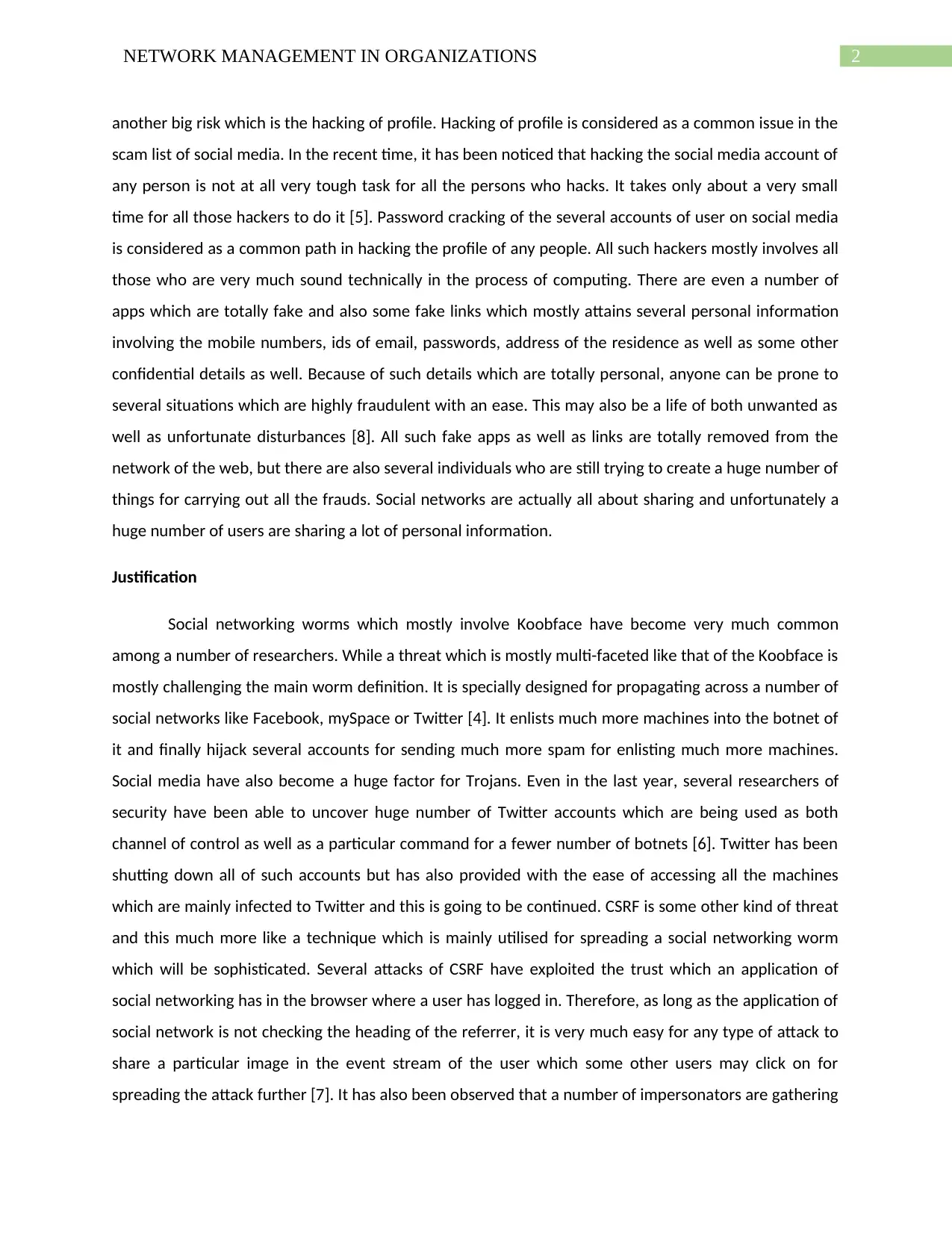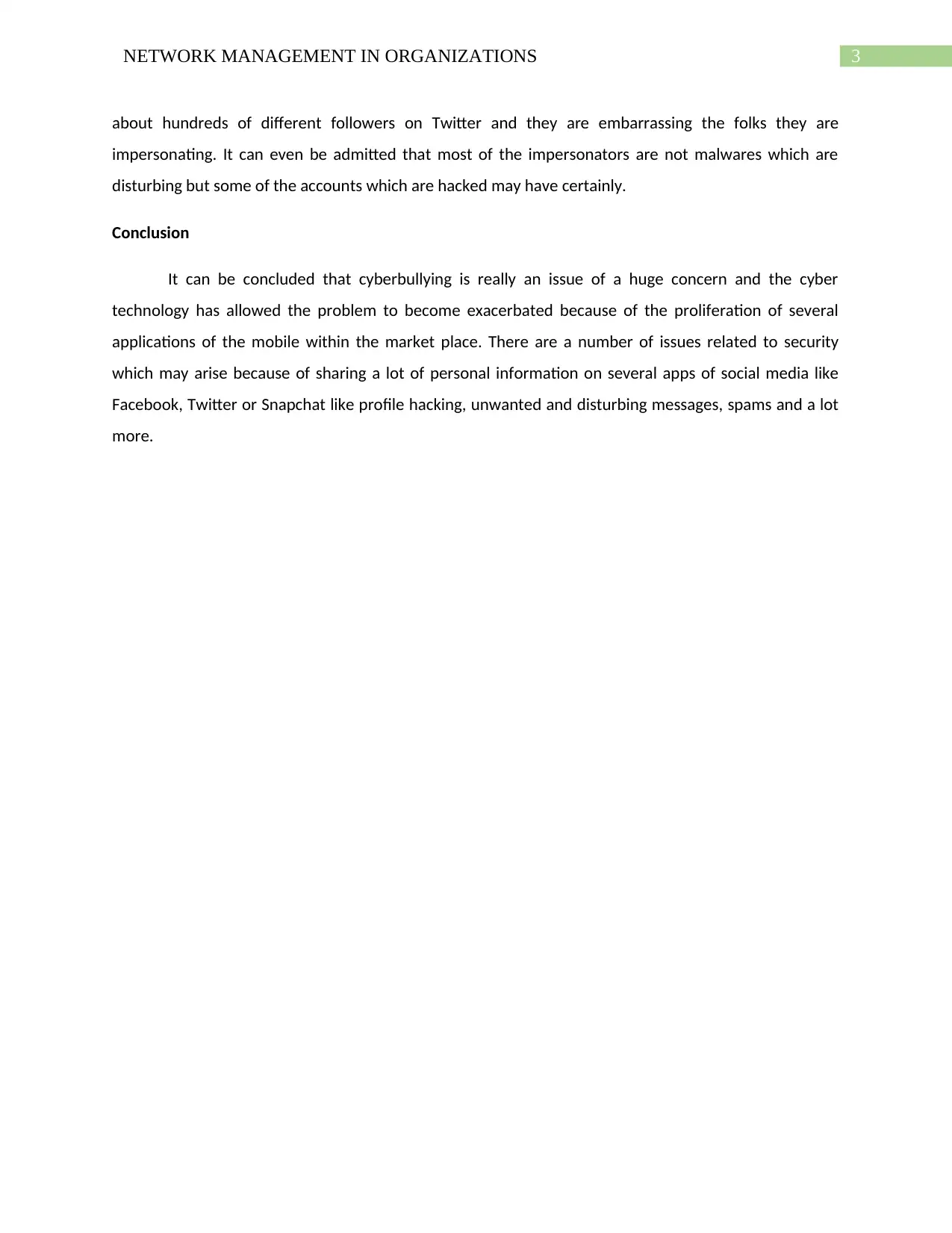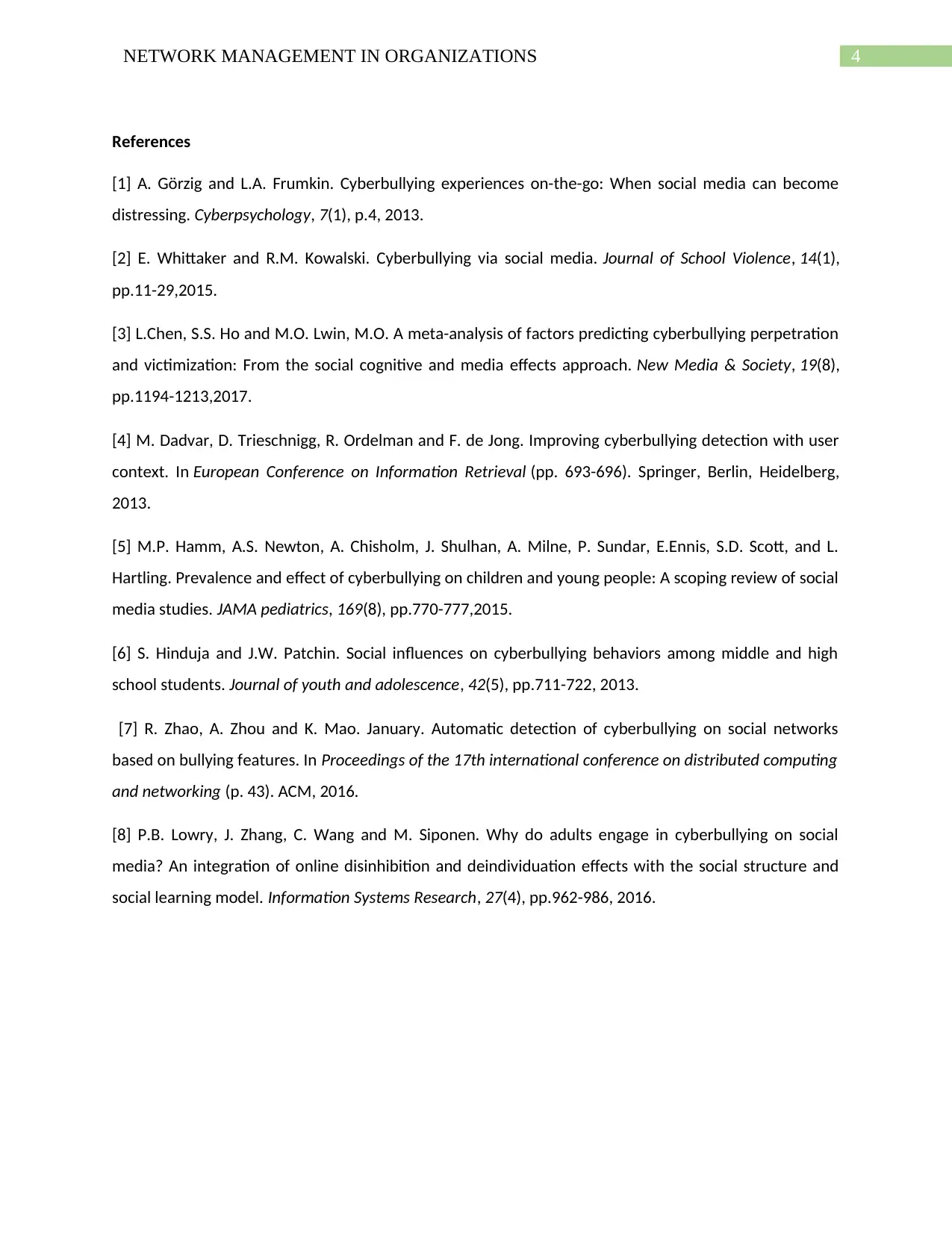Network Management in Organizations: Ethical Issues Report - MN501
VerifiedAdded on 2022/12/01
|5
|1578
|93
Report
AI Summary
This report, prepared for the MN501 Network Management in Organizations course, delves into the ethical challenges arising from the use of ICT technologies, particularly within the context of social media and network administration. It identifies key ethical issues such as cyberbullying, data breaches, identity theft, and the risks associated with sharing personal information on platforms like Facebook and Twitter. The analysis examines various threats, including fake profiles, malicious links, and profile hacking, and their impact on individuals and organizations. The report justifies these concerns by referencing relevant research and provides a conclusion summarizing the key issues and highlighting the need for vigilance in the use of social media and other online platforms to mitigate these risks. The report also discusses the application of ethical codes and proposes ethical solutions for IT systems administration, ensuring societal benefits.

Running head: NETWORK MANAGEMENT IN ORGANIZATIONS
NETWORK MANAGEMENT IN ORGANIZATIONS
Name of the Student
Name of the Organization
Author Note
NETWORK MANAGEMENT IN ORGANIZATIONS
Name of the Student
Name of the Organization
Author Note
Paraphrase This Document
Need a fresh take? Get an instant paraphrase of this document with our AI Paraphraser

1NETWORK MANAGEMENT IN ORGANIZATIONS
Introduction
Cyber bullying or rather cyber harassment is mainly a form of either harassment or bullying with
the use of several means which are electronic. Both cyberbullying as well as harassment are even known
as online bullying and it has been observed that this cyberbullying has become very much common
especially among a number of teens. Cyber bullying has really been an issue which is very much
significant globally over several few years [1]. The cyber technology has totally exacerbated this
particular problem because of the proliferation of the applications of mobile in the market place. A
notification has been received from a third party via one of the applications regarding participation in an
event. There is not much surety about how several details have been received by the third party. There
may a high chance of several issues related to security which may arise because of sharing a huge
amount of personal information on numerous Apps of social media.
Identification
Due to the excessive sharing of personal information through several social media apps, there
are a number of risks which may be harmful like an identity theft or rather a leakage of data. Other risks
may involve fake requests from several profiles which are spammed, hacking of profile, fake apps and a
number of links which are totally malicious [3]. Around about 12 million people in the year 2012 are
known to have suffered from a number of circumstances like the leakages of personal data and theft of
identity. This has further led to several fraudulent situations which are not desirable at all. On several
websites of social media like Facebook and Twitter, there are a number of users who mostly creates
accounts which are totally fake and using such fake accounts they are trying to make spams. Such fake
users of account may also lead to several viruses which may be very much harmful and they are let into
all our devices. For avoiding such type of issues which are really very serious, everyone must stay alert
during the use of several websites of social media.
Analysis
On the several websites of social media like Snapchat, Instagram and Facebook, there is a
special feature within which anyone can be able to share their recent locations and also their photos as
well [2]l. This actually provides a proof that it has become very much helpful for all the criminals of
social media for receiving a lot of information about the person. All such locations are clearly shown on
the web mainly in the address form which are mostly detailed and this excessive advanced feature are
leading towards a number of strangers who are actually wanting to contacting to people. There is
Introduction
Cyber bullying or rather cyber harassment is mainly a form of either harassment or bullying with
the use of several means which are electronic. Both cyberbullying as well as harassment are even known
as online bullying and it has been observed that this cyberbullying has become very much common
especially among a number of teens. Cyber bullying has really been an issue which is very much
significant globally over several few years [1]. The cyber technology has totally exacerbated this
particular problem because of the proliferation of the applications of mobile in the market place. A
notification has been received from a third party via one of the applications regarding participation in an
event. There is not much surety about how several details have been received by the third party. There
may a high chance of several issues related to security which may arise because of sharing a huge
amount of personal information on numerous Apps of social media.
Identification
Due to the excessive sharing of personal information through several social media apps, there
are a number of risks which may be harmful like an identity theft or rather a leakage of data. Other risks
may involve fake requests from several profiles which are spammed, hacking of profile, fake apps and a
number of links which are totally malicious [3]. Around about 12 million people in the year 2012 are
known to have suffered from a number of circumstances like the leakages of personal data and theft of
identity. This has further led to several fraudulent situations which are not desirable at all. On several
websites of social media like Facebook and Twitter, there are a number of users who mostly creates
accounts which are totally fake and using such fake accounts they are trying to make spams. Such fake
users of account may also lead to several viruses which may be very much harmful and they are let into
all our devices. For avoiding such type of issues which are really very serious, everyone must stay alert
during the use of several websites of social media.
Analysis
On the several websites of social media like Snapchat, Instagram and Facebook, there is a
special feature within which anyone can be able to share their recent locations and also their photos as
well [2]l. This actually provides a proof that it has become very much helpful for all the criminals of
social media for receiving a lot of information about the person. All such locations are clearly shown on
the web mainly in the address form which are mostly detailed and this excessive advanced feature are
leading towards a number of strangers who are actually wanting to contacting to people. There is

2NETWORK MANAGEMENT IN ORGANIZATIONS
another big risk which is the hacking of profile. Hacking of profile is considered as a common issue in the
scam list of social media. In the recent time, it has been noticed that hacking the social media account of
any person is not at all very tough task for all the persons who hacks. It takes only about a very small
time for all those hackers to do it [5]. Password cracking of the several accounts of user on social media
is considered as a common path in hacking the profile of any people. All such hackers mostly involves all
those who are very much sound technically in the process of computing. There are even a number of
apps which are totally fake and also some fake links which mostly attains several personal information
involving the mobile numbers, ids of email, passwords, address of the residence as well as some other
confidential details as well. Because of such details which are totally personal, anyone can be prone to
several situations which are highly fraudulent with an ease. This may also be a life of both unwanted as
well as unfortunate disturbances [8]. All such fake apps as well as links are totally removed from the
network of the web, but there are also several individuals who are still trying to create a huge number of
things for carrying out all the frauds. Social networks are actually all about sharing and unfortunately a
huge number of users are sharing a lot of personal information.
Justification
Social networking worms which mostly involve Koobface have become very much common
among a number of researchers. While a threat which is mostly multi-faceted like that of the Koobface is
mostly challenging the main worm definition. It is specially designed for propagating across a number of
social networks like Facebook, mySpace or Twitter [4]. It enlists much more machines into the botnet of
it and finally hijack several accounts for sending much more spam for enlisting much more machines.
Social media have also become a huge factor for Trojans. Even in the last year, several researchers of
security have been able to uncover huge number of Twitter accounts which are being used as both
channel of control as well as a particular command for a fewer number of botnets [6]. Twitter has been
shutting down all of such accounts but has also provided with the ease of accessing all the machines
which are mainly infected to Twitter and this is going to be continued. CSRF is some other kind of threat
and this much more like a technique which is mainly utilised for spreading a social networking worm
which will be sophisticated. Several attacks of CSRF have exploited the trust which an application of
social networking has in the browser where a user has logged in. Therefore, as long as the application of
social network is not checking the heading of the referrer, it is very much easy for any type of attack to
share a particular image in the event stream of the user which some other users may click on for
spreading the attack further [7]. It has also been observed that a number of impersonators are gathering
another big risk which is the hacking of profile. Hacking of profile is considered as a common issue in the
scam list of social media. In the recent time, it has been noticed that hacking the social media account of
any person is not at all very tough task for all the persons who hacks. It takes only about a very small
time for all those hackers to do it [5]. Password cracking of the several accounts of user on social media
is considered as a common path in hacking the profile of any people. All such hackers mostly involves all
those who are very much sound technically in the process of computing. There are even a number of
apps which are totally fake and also some fake links which mostly attains several personal information
involving the mobile numbers, ids of email, passwords, address of the residence as well as some other
confidential details as well. Because of such details which are totally personal, anyone can be prone to
several situations which are highly fraudulent with an ease. This may also be a life of both unwanted as
well as unfortunate disturbances [8]. All such fake apps as well as links are totally removed from the
network of the web, but there are also several individuals who are still trying to create a huge number of
things for carrying out all the frauds. Social networks are actually all about sharing and unfortunately a
huge number of users are sharing a lot of personal information.
Justification
Social networking worms which mostly involve Koobface have become very much common
among a number of researchers. While a threat which is mostly multi-faceted like that of the Koobface is
mostly challenging the main worm definition. It is specially designed for propagating across a number of
social networks like Facebook, mySpace or Twitter [4]. It enlists much more machines into the botnet of
it and finally hijack several accounts for sending much more spam for enlisting much more machines.
Social media have also become a huge factor for Trojans. Even in the last year, several researchers of
security have been able to uncover huge number of Twitter accounts which are being used as both
channel of control as well as a particular command for a fewer number of botnets [6]. Twitter has been
shutting down all of such accounts but has also provided with the ease of accessing all the machines
which are mainly infected to Twitter and this is going to be continued. CSRF is some other kind of threat
and this much more like a technique which is mainly utilised for spreading a social networking worm
which will be sophisticated. Several attacks of CSRF have exploited the trust which an application of
social networking has in the browser where a user has logged in. Therefore, as long as the application of
social network is not checking the heading of the referrer, it is very much easy for any type of attack to
share a particular image in the event stream of the user which some other users may click on for
spreading the attack further [7]. It has also been observed that a number of impersonators are gathering
⊘ This is a preview!⊘
Do you want full access?
Subscribe today to unlock all pages.

Trusted by 1+ million students worldwide

3NETWORK MANAGEMENT IN ORGANIZATIONS
about hundreds of different followers on Twitter and they are embarrassing the folks they are
impersonating. It can even be admitted that most of the impersonators are not malwares which are
disturbing but some of the accounts which are hacked may have certainly.
Conclusion
It can be concluded that cyberbullying is really an issue of a huge concern and the cyber
technology has allowed the problem to become exacerbated because of the proliferation of several
applications of the mobile within the market place. There are a number of issues related to security
which may arise because of sharing a lot of personal information on several apps of social media like
Facebook, Twitter or Snapchat like profile hacking, unwanted and disturbing messages, spams and a lot
more.
about hundreds of different followers on Twitter and they are embarrassing the folks they are
impersonating. It can even be admitted that most of the impersonators are not malwares which are
disturbing but some of the accounts which are hacked may have certainly.
Conclusion
It can be concluded that cyberbullying is really an issue of a huge concern and the cyber
technology has allowed the problem to become exacerbated because of the proliferation of several
applications of the mobile within the market place. There are a number of issues related to security
which may arise because of sharing a lot of personal information on several apps of social media like
Facebook, Twitter or Snapchat like profile hacking, unwanted and disturbing messages, spams and a lot
more.
Paraphrase This Document
Need a fresh take? Get an instant paraphrase of this document with our AI Paraphraser

4NETWORK MANAGEMENT IN ORGANIZATIONS
References
[1] A. Görzig and L.A. Frumkin. Cyberbullying experiences on-the-go: When social media can become
distressing. Cyberpsychology, 7(1), p.4, 2013.
[2] E. Whittaker and R.M. Kowalski. Cyberbullying via social media. Journal of School Violence, 14(1),
pp.11-29,2015.
[3] L.Chen, S.S. Ho and M.O. Lwin, M.O. A meta-analysis of factors predicting cyberbullying perpetration
and victimization: From the social cognitive and media effects approach. New Media & Society, 19(8),
pp.1194-1213,2017.
[4] M. Dadvar, D. Trieschnigg, R. Ordelman and F. de Jong. Improving cyberbullying detection with user
context. In European Conference on Information Retrieval (pp. 693-696). Springer, Berlin, Heidelberg,
2013.
[5] M.P. Hamm, A.S. Newton, A. Chisholm, J. Shulhan, A. Milne, P. Sundar, E.Ennis, S.D. Scott, and L.
Hartling. Prevalence and effect of cyberbullying on children and young people: A scoping review of social
media studies. JAMA pediatrics, 169(8), pp.770-777,2015.
[6] S. Hinduja and J.W. Patchin. Social influences on cyberbullying behaviors among middle and high
school students. Journal of youth and adolescence, 42(5), pp.711-722, 2013.
[7] R. Zhao, A. Zhou and K. Mao. January. Automatic detection of cyberbullying on social networks
based on bullying features. In Proceedings of the 17th international conference on distributed computing
and networking (p. 43). ACM, 2016.
[8] P.B. Lowry, J. Zhang, C. Wang and M. Siponen. Why do adults engage in cyberbullying on social
media? An integration of online disinhibition and deindividuation effects with the social structure and
social learning model. Information Systems Research, 27(4), pp.962-986, 2016.
References
[1] A. Görzig and L.A. Frumkin. Cyberbullying experiences on-the-go: When social media can become
distressing. Cyberpsychology, 7(1), p.4, 2013.
[2] E. Whittaker and R.M. Kowalski. Cyberbullying via social media. Journal of School Violence, 14(1),
pp.11-29,2015.
[3] L.Chen, S.S. Ho and M.O. Lwin, M.O. A meta-analysis of factors predicting cyberbullying perpetration
and victimization: From the social cognitive and media effects approach. New Media & Society, 19(8),
pp.1194-1213,2017.
[4] M. Dadvar, D. Trieschnigg, R. Ordelman and F. de Jong. Improving cyberbullying detection with user
context. In European Conference on Information Retrieval (pp. 693-696). Springer, Berlin, Heidelberg,
2013.
[5] M.P. Hamm, A.S. Newton, A. Chisholm, J. Shulhan, A. Milne, P. Sundar, E.Ennis, S.D. Scott, and L.
Hartling. Prevalence and effect of cyberbullying on children and young people: A scoping review of social
media studies. JAMA pediatrics, 169(8), pp.770-777,2015.
[6] S. Hinduja and J.W. Patchin. Social influences on cyberbullying behaviors among middle and high
school students. Journal of youth and adolescence, 42(5), pp.711-722, 2013.
[7] R. Zhao, A. Zhou and K. Mao. January. Automatic detection of cyberbullying on social networks
based on bullying features. In Proceedings of the 17th international conference on distributed computing
and networking (p. 43). ACM, 2016.
[8] P.B. Lowry, J. Zhang, C. Wang and M. Siponen. Why do adults engage in cyberbullying on social
media? An integration of online disinhibition and deindividuation effects with the social structure and
social learning model. Information Systems Research, 27(4), pp.962-986, 2016.
1 out of 5
Related Documents
Your All-in-One AI-Powered Toolkit for Academic Success.
+13062052269
info@desklib.com
Available 24*7 on WhatsApp / Email
![[object Object]](/_next/static/media/star-bottom.7253800d.svg)
Unlock your academic potential
Copyright © 2020–2025 A2Z Services. All Rights Reserved. Developed and managed by ZUCOL.




